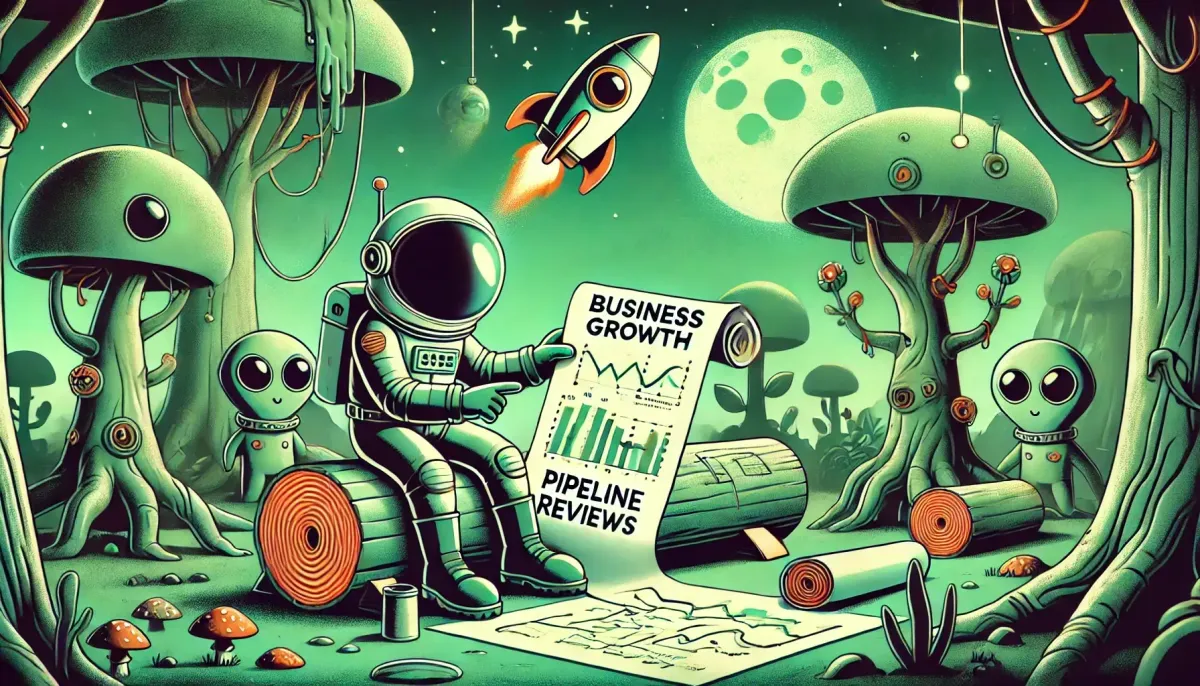Create a Winning Sales Plan for 2025
A good sales plan is aligned with market trends, tightly integrating sales and marketing, and clearly states roles and responsibilities. Key objectives include driving growth, retention, and managing high-value accounts. Here are our guidelines for creating one.

"Good morning, everyone. Thank you for being here today as we present our sales plan for the upcoming year."
Said the VP of Sales confidently while opening Sales Kick-Off 2025.
As this could be you in a few months, we at GTM Club offer our help.
Preparing for the upcoming year requires a solid sales plan that responds to emerging market trends and leverages the sales team's strengths. We suggest a plan focusing on three pillars: aligning your sales strategy with the market landscape, integrating sales and marketing efforts, and ensuring you have enough funding and the right risk profile.
You will have all the reasons to be confident.
Market Landscape and Sales Strategy
A vital aspect of a sales plan is understanding the factors that influence your strategy. Start by examining market insights and trends, identifying critical shifts in the industry, evolving customer needs, and the competitive landscape. This provides a clear view of opportunities and challenges to address.
Equally important is to align sales objectives and targets with these insights, setting realistic yet ambitious goals across different regions, products, and customer segments. The aim is to cover new customer acquisition and retention strategies while reducing churn.
The final element in this section is your sales initiatives—the major efforts you plan to undertake in the coming year, such as product launches and market expansions. This is a place to explain any plans you need to refine your value proposition due to competition. These initiatives ensure your go-to-market approach is proactive and adaptable.
Critical Areas for Consideration:
This first section answers what you aim to achieve next year and reasoning why you have selected the approach discussed in the next section.
- Market Insights and Trends
- Market trends: opportunities and challenges that might impact your business
- Changes in customer needs, how you segment your customer base, and if there are any meaningful changes in your ideal customer profile
- Competitive analysis: What is your competition doing, and if there is a threat of new players entering the fray?
- Sales Objectives and Targets
- Revenue goals (by region, product, customer segment - when relevant)
- How set revenue growth is achieved: new customer acquisition, cross-selling, upselling, etc
- Retention and churn management: How is current business developing? Is the exception that existing customers buy more or less from you? Why?
- Sales Initiatives
- Sales initiatives you launch: New products, market expansion, new customer segments, expanding strategic partnerships... there are many ways to grow!
- Updated messaging and unique selling proposition - are they changing? Is the message from 2024 still going strong in 2025?
- Customer acquisition and GTM Strategy: How do you select and win your battles?
Working through the plan's first section, you will get the big picture. You might need support from people working with customers and prospects, like account managers and SDRs, to pull in all the data for you to consider. Also, do note that when presenting the plan, ensure everyone understands the market landscape similarly to you. What might be crystal clear to you might not be equally clear to your boss or a fresh recruit.
Sales and Marketing Alignment
Your next focus is ensuring that sales and marketing teams are fully aligned to achieve the set sales targets - working together!
Start by addressing the sales team structure and individual focus areas, outlining the team members' roles and responsibilities. If you do this part well, everyone should understand what is expected of them. Scaling the team through hiring and training will ensure the team has the right skills onboard to support growth in the future, too.
Performance must be tracked to reach the goals. Explain the KPIs and metrics the team needs to follow in the plan. Big surprises are unlikely with sales KPIs, but it's worth recapping the most relevant ones, such as sales cycle and win rate. You should explain what these KPIs are today and how they need to improve during the year. Also, mention here if you are changing how the team is managed, for example, if there will be regular pipeline reviews to accelerate sales.
Lastly, the marketing plan will outline how marketing efforts will support sales. This includes defining marketing goals, messaging, and the channels the marketing team will leverage for lead generation and customer engagement. Strong collaboration between sales and marketing will ensure a seamless approach to hitting the shared targets. Related to the above, ideally, sales and marketing share some KPIs.
Essential Areas for Consideration:
The previous section explained what you will do and why; this one shares details on how to do it and backs it up with numbers and names.
- Sales Team Structure and Focus
- Role assignments and individual sales budgets: Who sells to who and how much. Everyone on the team must know what is expected of them.
- Key account management and high-value prospects: Which prospective accounts are must-win and will move the needle big time? Which accounts need to grow next year, and how is that growth secured?
- Sales team development: When to look for new hires? What kind of training should be provided to remove skill gaps in the team?
- Performance Metrics and KPIs
- Sales pipeline overview and forecasting: When making the plan, forecast where you will start next year—plan from where you will begin, not where you should be at year's end.
- Key metrics: Know your metrics so your budgeting and forecasting are correct. Decide which metrics to improve next year. Average deal size is always a good choice.
- KPIs to support initiatives: Align KPIs with the big picture. If you launch a new product, track relevant progress toward the set budget.
- Marketing Plan
- Marketing goals: Is marketing working on lead generation, or is a brand and website redo taking up all the resources?
- Key activities and marketing channels: What is marketing doing this year, and how does it impact sales? Double down on marketing supporting sales like lead generation.
- Sales & marketing alignment: You should be working together. How does that show in daily operations?
Once you have calculated and have names on all important KPIs in this part of the plan, you should know if you are aiming for too high or low growth targets. Adjust the plan accordingly or circle back to objectives and targets if needed.
Budget, Risk Management, and Execution
The final section of our plan lays the groundwork for execution. It begins with budget and resource allocation, ensuring that investment is aligned with growth ambitions. This includes planning for new hires, sales compensation, and marketing spending while keeping operational costs in check. Issues here might lead to circling back to the beginning or previous section. Ensure you spend enough time on the budget to justify any new resources you need.
Pay attention to the available budget. Don't accept a mission impossible.
Finally, as icing on the cake, one must also spend time on risk and contingency planning to avoid or mitigate nasty surprises. During the year, both internal and external risks could materialise. Such events could be personnel challenges, market fluctuations, and product or feature launches from competitors. You will save on stress levels if you have contingency plans to mitigate these risks. A black swan event might happen, but you are still better off with some emergency plans than none.
Finally, the timeline and key milestones will map the year’s goals by months or quarters and outline the critical deliverables for your strategic initiatives. There is no need to reinvent the wheel here; if you have a system that works, use it.
Main Areas for Consideration:
Ensure you spend enough time on the budget to justify any new resources you need. The budget brings all three sections together into a comprehensive plan.
- Budget and Resource Allocation
- Sales and marketing budget allocation
- New hires: who, when, and how expensive are they?
- Operational costs and sales compensation plan (everyone's favourite item in a sales kick-off!)
- Risk and Contingency Planning
- Internal risks: hiring delays, personnel churn, product launch postponed...
- External risks: competition, market developments, economic shifts...
- Contingency plans to keep everyone calm.
- Timeline and Key Milestones
- Monthly/quarterly sales goals will keep you on track.
- Milestones for key sales initiatives serve the same purpose.
- Progress monitoring, both team-level and individual sellers, keeps everyone in line.
We recommend updating the sales plan as the year progresses and progress is tracked. There are a lot of things that change during a year, and reaction is most likely needed. Like a battle plan, which is good until you meet the enemy, a sales plan is good until the first opportunities are closed.
Let’s get started, then!





